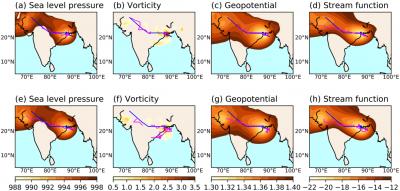Assessing Past Trends in Atmospheric Vortices in Monsoon Regions Using an Optimized Algorithm and Global Dataset
A team of researchers working as part of the Department of Energy’s Monsoon Extremes project created a fast, optimized algorithm to identify monsoon low-pressure systems in large ensembles of high-resolution datasets, making it possible to accurately identify these important storms in estimates of past, present, and future atmospheric states.
The global datasets created by this work provide a new basis for understanding the transient atmospheric vortices that deliver rainfall to many low-latitude continental regions on Earth. These datasets were used to show that a previously claimed large decrease in South Asian monsoon depressions may be an artifact of the introduction of satellite observations in the early 1980s.
This study created a fast, objective algorithm for identifying monsoon vortices in high-resolution atmospheric datasets, then used that algorithm to assess past changes in these vortices. The algorithm was designed to best match a hand-analyzed dataset while minimizing disagreement between four different observational estimates of the atmospheric state in a training period. While algorithms used to track related vortices such as hurricanes often rely on a variable called the vorticity, this study found that the vorticity is overly noisy for this class of monsoon storms and that a smoother quantity called the streamfunction proved much more skillful. Using the optimized algorithm, vortex statistics were computed for five different observational estimates of the historical atmospheric state, and none showed a detectable trend in monsoon vortex counts since 1979. Both the Japanese 55‐year Reanalysis (JRA‐55) and the India Meteorological Department (IMD) dataset showed a step‐like reduction in counts when they began using geostationary satellite data, in 1979 and 1982 respectively; the 1958‐2018 linear trend in JRA‐55, however, was smaller than in the IMD dataset and its error bar included zero. There were more vortices in seasons with above‐average monsoon rainfall and in La Niña years, but few other large‐scale modes of interannual variability were found to modulate storm counts, lifetimes, or track length consistently across data products.

